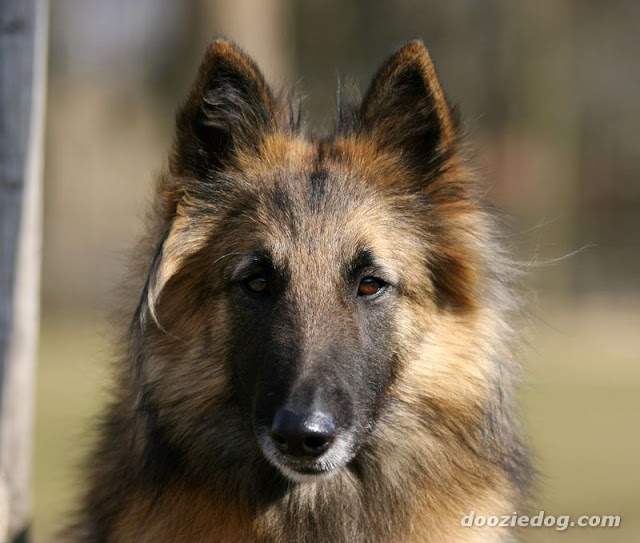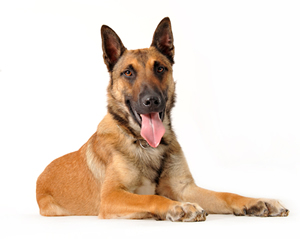Fast Facts
| Group classification: Herding | Country of origin: Belgium | Date of origin: 19th century |
| Weight (M): 55 - 65 lb | Height (M): 24 - 26" | Life expectancy: 10 - 12 years |
| Weight (F): 40 - 50 lb | Height (F): 22 - 24" |
General Description of the Belgian Tervuren
The Belgian Tervuren is a medium-sized dog that is strong, square and well-proportioned. The head is long without being overly so and features dark brown eyes that are slightly almond shaped. The expression is one of alertness, curiosity and intelligence. Ears are set high on the head, triangular and stiff with a height that is equal to the width at the base. The skull top and muzzle are of equal length, giving the head a balanced and proportionate appearance. The muzzle is not overly pointed or overly cheeky, but rather moderately rounded. The nose should be totally black without discoloration with well defined nostrils. The tail is strong and sturdy at the base and slightly curved when the dog is active. Body color ranges from fawn to mahogany with black tipping. As the Belgian Tervuren matures, the coat becomes darker. The chest area of the Tervuren is predominately black or a mixture of dark gray and black. The coat is medium in harshness with long guard hairs to protect against harsh climates. Hair is longer around the collarette area, breeches and tail.
Belgian Tervuren Temperament
The Belgian Tervuren is energetic and highly alert. Though somewhat independent by nature, this dog is nevertheless easy to train. It is crucial to socialize this breed from puppyhood to prevent shyness or aggression. Because the Tervuren is a herding dog, it can sometimes nip at the heels of small children or other pets. You'll find that the Tervuren is a loyal and protective pet and is ideal as a family watchdog. The Belgian Teruven is most content when it has a task to do, so it is very important to work with your dog daily. They require a good bit of exercise and activity and are not the right dog for a sedentary owner. Though totally devoted to its entire family, Belgian Tervuren may "play favorites," gravitating toward one family member above the rest.
Caring for a Belgian Tervuren
The Belgian Tervuren is a highly active dog, and requires regular vigorous exercise. Allow your Tervuren to run free in a park or field, or take it for a long jog every day. This breed is a continual shedder, and will shed quite heavily during the warmer months. This is why it is so important to groom your Tervuren daily, using a sturdy bristled brush as well as a detangling comb. Mats should be trimmed with grooming shears, and you may also need to trim the hair that grows between the toes. When bathing your Belgian Tervuren use a mild dog shampoo and try not to bathe more frequently than once a month. Health concerns of note include seizures, canine hip dysplasia, elbow dysplasia, allergies, hypothyroidism and progressive retinal atrophy.
The Belgian Tervuren is a medium-sized dog that is strong, square and well-proportioned. The head is long without being overly so and features dark brown eyes that are slightly almond shaped. The expression is one of alertness, curiosity and intelligence. Ears are set high on the head, triangular and stiff with a height that is equal to the width at the base. The skull top and muzzle are of equal length, giving the head a balanced and proportionate appearance. The muzzle is not overly pointed or overly cheeky, but rather moderately rounded. The nose should be totally black without discoloration with well defined nostrils. The tail is strong and sturdy at the base and slightly curved when the dog is active. Body color ranges from fawn to mahogany with black tipping. As the Belgian Tervuren matures, the coat becomes darker. The chest area of the Tervuren is predominately black or a mixture of dark gray and black. The coat is medium in harshness with long guard hairs to protect against harsh climates. Hair is longer around the collarette area, breeches and tail.
Belgian Tervuren Temperament
The Belgian Tervuren is energetic and highly alert. Though somewhat independent by nature, this dog is nevertheless easy to train. It is crucial to socialize this breed from puppyhood to prevent shyness or aggression. Because the Tervuren is a herding dog, it can sometimes nip at the heels of small children or other pets. You'll find that the Tervuren is a loyal and protective pet and is ideal as a family watchdog. The Belgian Teruven is most content when it has a task to do, so it is very important to work with your dog daily. They require a good bit of exercise and activity and are not the right dog for a sedentary owner. Though totally devoted to its entire family, Belgian Tervuren may "play favorites," gravitating toward one family member above the rest.
Caring for a Belgian Tervuren
The Belgian Tervuren is a highly active dog, and requires regular vigorous exercise. Allow your Tervuren to run free in a park or field, or take it for a long jog every day. This breed is a continual shedder, and will shed quite heavily during the warmer months. This is why it is so important to groom your Tervuren daily, using a sturdy bristled brush as well as a detangling comb. Mats should be trimmed with grooming shears, and you may also need to trim the hair that grows between the toes. When bathing your Belgian Tervuren use a mild dog shampoo and try not to bathe more frequently than once a month. Health concerns of note include seizures, canine hip dysplasia, elbow dysplasia, allergies, hypothyroidism and progressive retinal atrophy.


















































